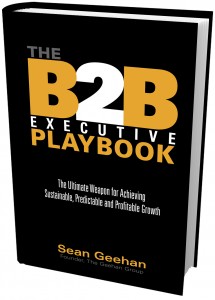 When I play the part of a buyer in sales call role plays, the salesperson often launches into a recitation of their product’s features and capabilities, which are easily countered by pointing out that their competitors offer the same features, and at a lower price. After they run into several dead-ends, the next tactic is to play the personal card: “Well, you get me as part of the deal.” That’s when I reply with my one-size-fits-all buyer’s question:
When I play the part of a buyer in sales call role plays, the salesperson often launches into a recitation of their product’s features and capabilities, which are easily countered by pointing out that their competitors offer the same features, and at a lower price. After they run into several dead-ends, the next tactic is to play the personal card: “Well, you get me as part of the deal.” That’s when I reply with my one-size-fits-all buyer’s question:
“SO WHAT?”
When I ask that question, most salespeople don’t have a good answer. They can tell me that they will be accessible and that they will take personal responsibility for my satisfaction, but everyone can tell a buyer that. On the other hand, it’s clear that many buyers will be loyal to a vendor because of the quality of the relationship they have with the salesperson, so it’s actually a pretty good answer—IF the buyer believes it and trusts you to deliver on the promise.
The trick to making the buyer believe it is not to say it, but to prove it with actions. What should your actions show?
There are four critical attributes you have to show that will induce buyers to trust you. I first read these attributes in Jerry Acuff’s excellent book, The Relationship Edge: The Key to Strategic Influence and Selling Success. Acuff talks about these, but the acronym and the description of what each one means are my own take, so if you don’t agree, blame me.
PICK stands for professionalism, integrity, caring, and knowledge.
Professionalism: Professionalism is the personal stamp of quality that you display in all your interactions with customers. Do you make dealing with you effortless and reliable? Do you follow through on your commitments? Can you get things done within your own organization for your customers? Do you communicate clearly and consistently? Are you punctual and prompt? If you have to speak about your competitors, can do it objectively and fairly?
Integrity: This one should go without saying, but unfortunately pressure is so often put on salespeople to make this quarter’s number that shades of grey can be rationalized to seem whiter than they are in some cases. People may not always notice when you act with integrity, but they will instantly pick up on it when you don’t. Do you honor your commitments? Would you recommend against your own product if you believe it’s not the right thing for your customer? Are you fair and honest at all times? Do you have the guts to tell your customer when you think they’re wrong? Or your sales manager? Do you address problems squarely and promptly?
Caring: Reports of the death of relationship selling are exaggerated. Sales transactions are just as much a social exchange as an economic one, and everyone responds to a personal connection. Do you make buyers feel that they are more than a number that goes toward your quota? Will you take active responsibility to ensure they get the results you promise? Do you follow up to ensure that your customer is satisfied and happy?
Knowledge: Although I just said that relationship selling is important, you still have to bring real business value to your customers, and value comes from bringing fresh insights that help them get faster, better, or cheaper in some way. Do you bring new ideas to improve the customer’s business? Do you know how to connect your solution to profits, processes and problems? Do you know how to make your customers succeed personally?
If you can consistently demonstrate the values of professionalism, integrity, caring and knowledge in all your dealings with customers and prospects, the customer’s “So what?” questions will be easy to answer. More importantly, it will probably never be asked.
Everyone talks about the importance of customer focus, but very few salespeople apply the idea to their sales presentations, according to my interviews with top executives who have sat through hundreds of sales presentations. They complain about presentations that focus primarily on the presenting company, with slide after slide detailing their story and showing pictures of their corporate headquarters. Or, the presentation is all about the product being sold. Even if they do care about your company, they probably already know all they want or need to know—buyers are better informed than ever.
It’s easy to fall into the trap when you’re preparing your presentation. First, you are justly proud of your company and of your offerings, so it’s altogether human to want to talk about them. Second, you probably have no shortage of presentation templates available to you, put together by your marketing department, so it’s very convenient—maybe even mandatory to use them. Out of habit, you fail to realize how seller-centric your presentations might be.
So, here are a few filters you can use to test your own presentation before you go out and bore yet another prospect. They broadly fit into two categories: content and demeanor.
Customer-focused Content: Problems, Processes and Profits
Problem first, then solution. Solutions are unnecessary without problems. You might think that the problem is understood by everyone, so there is no need to talk about it, yet that’s wrong for two reasons.
First, talking knowledgeably about the customer’s problem is the best way to establish your credibility, far better than touting your credentials or telling them how many locations your company has. And I’m not just referring to a generic description of the problems your solution addresses—you have to show that you have done the research to understand this specific customer and their perspective on the problem.
The second reason is that even when the audience agrees on the description of the problem, they don’t all agree on its impact. In fact, everyone in the room may be impacted slightly differently, depending on their function or position within the company. Buying a solution represents change, and change is risky. So, your goal is to make the listeners feel that not changing is the greater risk.
Take a look at your presentation: do you talk about their problems, challenges and opportunities? How many slides are about them vs. about you?
Process improvements. Another excellent way to gain credibility and respect is to talk about their processes. Most B2B sales opportunities are about improving some aspect of the customer’s business processes. Show your expertise in their business by describing a day in the life of a process owner, both before and after, using their own language or terminology when possible. In my own sales processes, I try to spend time with a typical sales rep during the fact-gathering stage, and when I talk about this in my own presentations, it’s usually the most engaging part, especially when I can bring up anecdotes or examples. Showing that you’ve been on the scene where the process takes place is enormously credible. Do you talk about their business processes? Do you understand their steps, inputs required, outputs, and limitations? Do you talk about how to make their processes faster, better or cheaper?
Talk profits, not products. The language that resonates with the highest-level decision makers is that which talks about their own personal scorecards: the financial impact of their decisions. If solution selling is about solving problems and fixing processes, consultative selling is mostly about understanding and being able to express the business impact of your product or service. How much of your presentation addresses the business impact? What is the effect on revenue, costs, or asset efficiency?
Customer-focused Demeanor
Besides content, the way you present yourself can also demonstrate how customer-focused you are. Although it may appear to contradict what I said earlier about showing your knowledge, you have to be careful how you do it. If you try too hard to show how much you know about the customer, they may decide to cut you down to size a little. Be confidently tentative when you present your perception of the problem, and invite their comments. This will put you on the same side of the desk with the people in the room and ensure a shared understanding of the situation.
Another very simple test is to pay attention to your pronouns. How many times do you use “I” or “we” vs. “you”?
Finally, don’t be so focused on getting your message out that you forget to monitor messages in. Are you paying attention to the audience’s reaction and adjusting your talk accordingly? Are you encouraging questions and interactivity?
If you apply these test to what you are saying and how you are saying it, every member of the audience is likely to come away feeling that you have been speaking directly to them, and that is a wonderful thing to strive for in any presentation.
 I was running a class for sales training facilitators last week, when the conversation turned to the similarities between teaching and selling. Good salespeople do a lot of teaching, and good teachers do a lot of selling. Both professionals only succeed if their customers or pupils do—you can’t be a teacher unless someone learns, and you can’t sell without someone buying.
I was running a class for sales training facilitators last week, when the conversation turned to the similarities between teaching and selling. Good salespeople do a lot of teaching, and good teachers do a lot of selling. Both professionals only succeed if their customers or pupils do—you can’t be a teacher unless someone learns, and you can’t sell without someone buying.
Churchill said, “Personally, I’m always ready to learn, although I do not always like to be taught”, a phrase which mirrors the old sales adage that people like to buy but don’t like to be sold, and the skills required to get them to this point are the same for both professions.
Both professions know that their success hinges on commanding attention, and both know they have to tune in to WIFM (What’s in it for me?) to get the attention of their listeners. My brother-in-law, a high school math teacher, is always asked by his students why they need to learn some formulas or operations that they will probably never use. He tells them it’s like mental weightlifting: you won’t do those exact movements in sports or in daily life, but it strengthens your muscles for the movements you do make.
Except for transactional sales that can be closed in one call, both professions rely on the listener taking appropriate action based on the information they receive. It’s not enough that they get it; you have to ensure that they act on it. For example, when I run a training session I always tell the students that I see it as a sales call, in which my purpose is to gain their willing commitment to use the processes and techniques they learn during the session. The best way to ensure that they will act on what you tell them is to make it their idea. That’s why salespeople and teachers both use questions to draw the right thinking out of the customer or the pupil. Whether it’s SPIN selling or the Socratic method, both approaches recognize that when the other person discovers something for themselves, compliance or learning are much more likely.
With teachers as well as salespeople, their listeners may question or object to what they are telling them, and that is a good thing. The poor ones in each profession want to get through their sales or lesson plan as efficiently as possible, with a minimum of interruptions, but the good ones know that the lack of questions is a bad thing, because it means that the other person just does not care enough to put up a fuss. Besides, the toughest objection to handle is the one you don’t get. The best teachers encourage healthy debate and have the humility to learn from the pupil; excellent salespeople listen far more than they speak. But both also have the confidence in their message that they are willing to challenge the other when they just don’t get it.
Persuasion often requires teaching, and teaching often requires persuasion. If you teach, think about doing a little more selling; if you sell, think about doing a little more teaching.
 So, you think your company is customer-focused? If you’re not involving the top executives of your top accounts in your planning, you’re not as customer-focused as you could be. While every B2B company pays lip service to customer focus, few go as far as the prescriptions in The B2B Executive Playbook: The Ultimate Weapon for Achieving Sustainable, Predictable and Profitable Growth
So, you think your company is customer-focused? If you’re not involving the top executives of your top accounts in your planning, you’re not as customer-focused as you could be. While every B2B company pays lip service to customer focus, few go as far as the prescriptions in The B2B Executive Playbook: The Ultimate Weapon for Achieving Sustainable, Predictable and Profitable Growth, by Sean Geehan, to make it a reality.
In B2B sales, there is a surprisingly small group of individuals who hold the most control over your fate—your revenue, profitability and market share. They are the executive decision makers of your best customers.
- How often do you talk to them?
- How well do you really know what they think about your company and your offerings?
- Do you know exactly why they buy from you?
- Does your perception of your strengths and weaknesses jibe with theirs?
- If you picked up the phone to call each one, what would happen?
This last question is taken from page 95, which in itself is worth the price of the book. Geehan provides a simple assessment you can use to figure out where you stand on the B2B relationship continuum, which has five descriptions ranging from Commodity Supplier to Business Partner. The phone call test for each one is simple and powerful—and if you answer it honestly, you probably will be disturbed by the result.
The theme of the book is about how to achieve sustainable, predictable and profitable growth (SPPG) through close and active engagement with your top executive customers. While this may not seem like a huge revelation, very few companies do it well, and the value in this book consists of its specific four-step plan for how to accomplish this.
Engage: “Engagement means executive customers are talking to your leadership team directly and without filters.” In this section, Geehan explains how to establish and use an Executive Customer Advisory Council (ECAC) to get your top customers engaged in the process, and whom to include. Because they are the ones who write the really big checks, you can’t leave it entirely in the hands of your account managers; your own executive leadership must be continuously and deeply engaged with them.
Plan: Every company has a strategic planning process, in which they make decisions about strategy, products, markets, resource allocation, etc., but very few involve the stakeholders who vote with their dollars to approve or disapprove of their plans. Geehan advocates Market-Aligned Planning, which uses customer input to help identify which strategies to eliminate, evolve, or acquire.
Collaborate: Most companies equate relationship-building with entertainment. Geehan recommends a much deeper process called Account-Based Innovation, which uses customer inputs to inform choices about R&D and make innovation relevant (and worthwhile). Companies have long learned to minimize internal silos that slow down innovation—this process eliminates the last remaining silo, that between companies and their customers. 60-70% of new products in the B2B space fail; why not give the customer a voice before the cost, trouble and time go into the launch?
Grow: When customers have an early and active role in your planning processes, they often become your best salespeople within their industries. The book cites the example of Henny Penny Corporation, which used the process to design a low oil volume fryer for McDonald’s. That breakthrough led to their being named Worldwide Equipment Partner[1] of the Year in 2010, and that kind of publicity was priceless for other customers.
This book is not for everyone: it’s clearly aimed at those within the company who have primary responsibility for revenue growth. It offers offers clear, direct prescriptions, backed by numerous examples that provide credibility and illumination to the author’s thesis. If you want to listen to the Voice of the Customers that really matter, this book will show you how.



